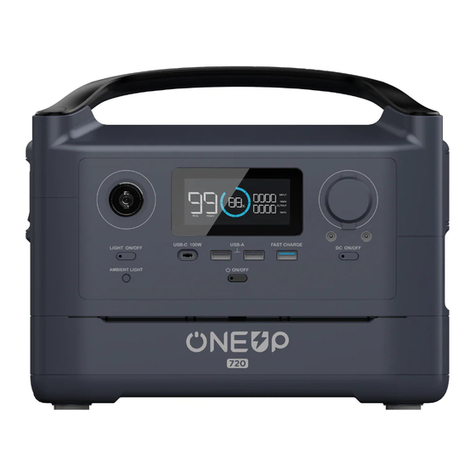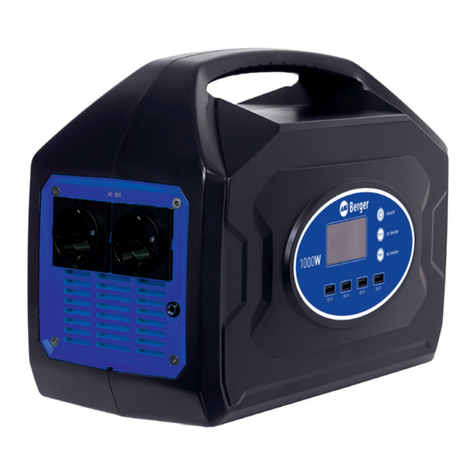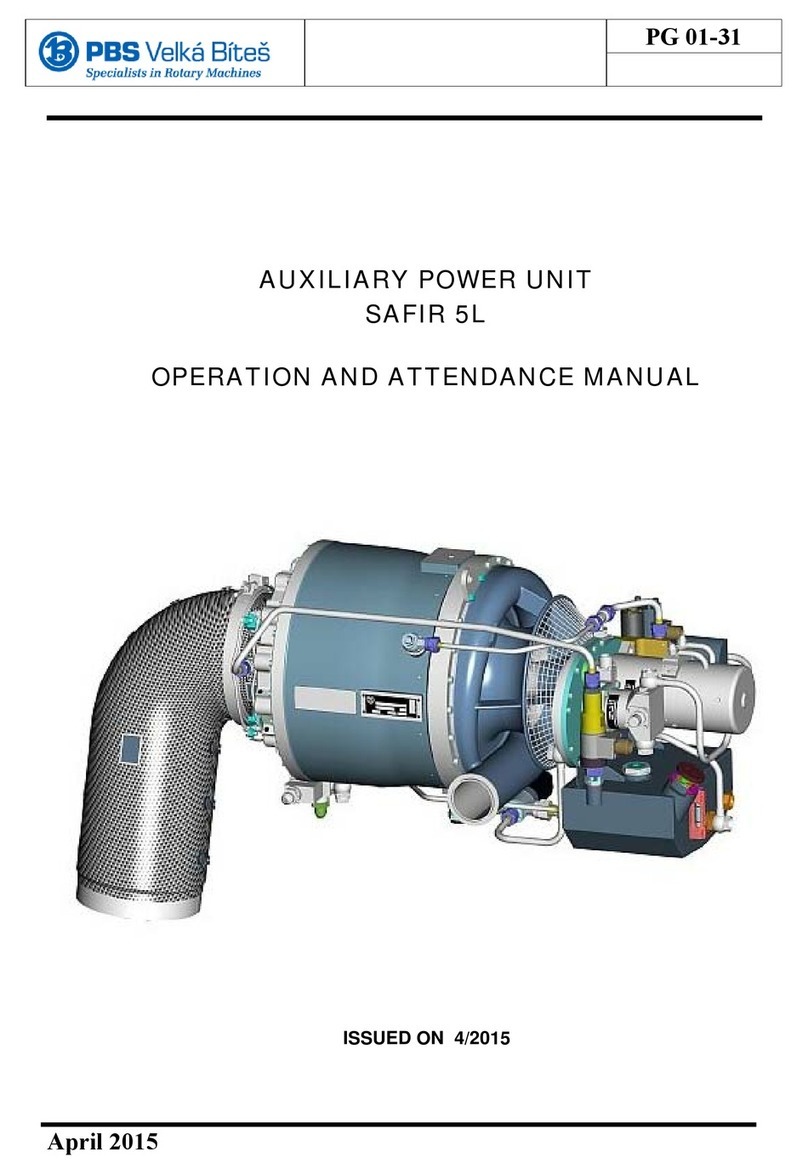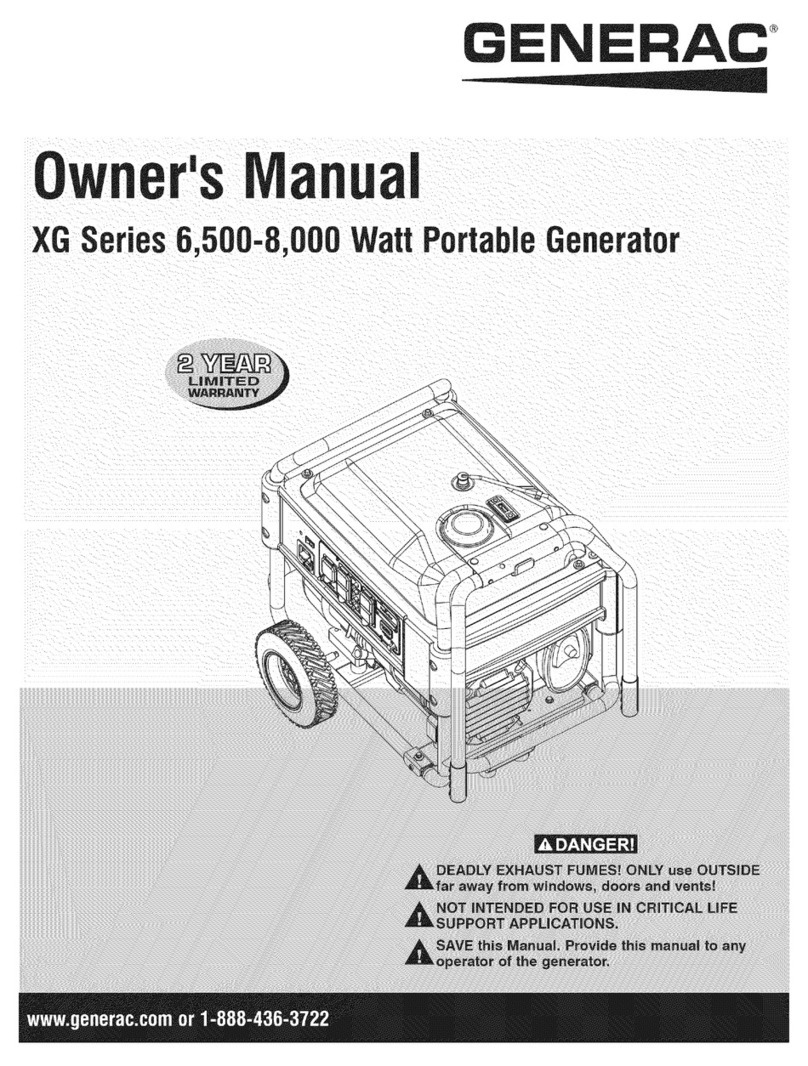green ecotherm Pelletherm V.5/GENERATO Series Specification sheet

page 1/47
MANUAL
FOR INSTALLATION AND OPERATION
OF AUTOMATED PELLET HOT AIR GENERATOR FROM
SERIES
Pelletherm V.5/GENERATO
http:// www.greenecotherm.eu

page 2/47
The manufacturing company thanks you for the contribution of your choice.
The manufacturing company provides this manual in help to the team that will install, adjust and
service this system, as well as to the customer that will operate it.
The manufacturing company requires that the technicians performing the above presented
procedures has passed training course for the activities performed with the product.
EXPLANATION: The notation “Pelletherm V.5/GENERATO” has been used in the current manual,
which includes the hot air generator models GENERATO 30”, ”GENERATO 40” and „GENERATO
50”.
WARNING!
IN THE INTEREST OF YOUR SAFETY IT IS RECOMMENDED AND TO READ CAREFULLY
AND TO BECOME FAMILIAR WITH THIS MANUAL, BEFORE YOU TAKE ANY ACTIONS FOR
INSTALLATION AND OPERATION OF THIS APPLIANCE. NON COMPLIANCE WITH THE
INSTRUCTIONS DESCRIBED BELOW, MAY LEAD TO DAMAGES AND FATALITIES, FOR
WHICH THE MANUFACTURING COMPANY DOES NOT TAKE RESPONSIBILITIES.
Manufacturer ZMM Haskovo PLC.
Address 67 Saedinenie, 6300 Haskovo, Bulgaria
Telephone +359 800 15 145
Fax +359 38 603070
e-mail greenecotherm@erato.bg
home page www.greenecotherm.eu
MANUAL FOR INSTALLATION AND OPERATION OF
AUTOMATED PELLET HOT AIR
GENERATOR
FROM SERIES Pelletherm V.5/GENERATO
(EDITION : 14.12.2012 г. 10:55)

page 3/47
CONTENT
page.
1. DESCRIPTION AND ADVANTAGES OF HOT AIR GENERATOR FROM SERIES
“PELLETHERM V.5/GENERATO”..............................................................................................4
2. TECHNICAL DATA FOR HOT AIR GENERATOR FROM SERIES
“PELLETHERM V.5/GENERATO”..............................................................................................6
3. CONSTRUCTION DESCRIPTION OF AUTOMATED HOT AIR GENERATOR
FROM SERIES “PELLETHERM V.5/GENERATO”..............................................................10
4. MOUNTING AND INSTALLATION................................................................................16
4.1. GENERAL CONDITIONS:...............................................................................................16
4.2. NORMS AND REGULATIONS.......................................................................................16
4.3. INSTALLATION OF THE GENERATOR......................................................................17
4.4. POSITIONING OF THE GENERATOR FOR EASY MANUPULATION..................17
4.5. CONNECTING THE GENERATOR TO A CHIMNEY.................................................18
4.6. СONNECTING THE GENERATOR TO AN AIR-FUNNEL FOR SUPPLYING THE
HEATING SYSTEM WITH HOT AIR .........................................................................................21
5. INITIALIZING THE APPLIANCE IN OPERATION......................................................23
5.1. GENERAL FUEL REQUIREMENTS .........................................................................23
5.2. INITIALIZIATION OF AUTOMATED PELLET HOT AIR GENERATOR FROM
SERIES “PELLETHERM V.5/GENERATO” IN OPERATION..............................................23
5.2.1. INTERFACE CONTROL PANEL OF AUTOMATED PELLET HOT AIR
GENERATOR FROM SERIES “PELLETHERM V.5/GENERATO”.....................................24
5.2.2. CONNECTION PANEL OF HOT AIR GENERATOR FROM SERIES
“PELLETHERM V.5/GENERATO”............................................................................................26
5.2.3. GENERATOR POWER SUPPLY.................................................................................26
5.2.4. GENERATOR SWITCH ON..........................................................................................27
5.2.5. PARAMETERS FOR OPERATION ADJUSTMENT OF THE GENERATOR. .....28
5.2.6. ADJUSTING THE GENERATOR FROM SERIES “PELLETHERM
V.5/GENERATO” ACCORDING TO THE HEATING OUTPUT, CONSUMED BY THE
HEATED BUILDING/ CONSUMING APLLIANCES...............................................................31
5.2.7. CHANGING THE CONTROL MODULE OPERATION PARAMETERS. ..............34
5.2.8. NOMINAL OPEARATION MODE OF THE GENERATOR......................................36
5.3. REGULATING THE GENERATOR HEATING OUTPUT.......................................37
5.3.1. DECREASING THE GENERATOR HEATING OUTPUT. .......................................37
5.3.2. INCREASING THE GENERATOR HEATING OUTPUT..........................................37
5.3.3. ADJUSTMENT OF PARAMETERS FOR SUPPLYING THE HEATING AIR
FUNNEL SYSTEM........................................................................................................................38
5.4. STOPPING THE GENERATOR OPERATION. .......................................................38
5.5. GENERATOR SWITCH OFF......................................................................................38
5.6. INTRODUCING THE USER WITH THE APPLIANCE MAINTENANCE AND
ADJUSTMENT PROCEDURES.................................................................................................39
5.7. CLEANING THE GENERATOR.................................................................................39
5.8. SAFETY AND UNPREDICTED RISKS.....................................................................41
5.9. FAILURES AND TROUBLESHOOTING..................................................................42
5.10. COMPLETION OF THE APPLIANCE WARRANTY CARD....................................44
5.11. ACTIVITIES AFTER THE APPLIANCE LIFE CYCLE PERIOD EXPIRY. ..........44
6. WIRING DIAGRAM OF THE APPLIANCE...................................................................45

page 4/47
1. DESCRIPTION AND ADVANTAGES OF HOT AIR GENERATOR FROM SERIES
“PELLETHERM V.5/GENERATO”.
The series “Pelletherm V.5/GENERATO” are steel made biomass hot air generators used
for drying installations and heating of domestic, office, industrial premises and public facilities.
The hot air generators from series “Pelletherm V.5/GENERATO” utilize fuel, described below,
as the produced heat energy is transferred to the heat carrier – ambient air. The heated air
from the appliance is transferred to neighbor premises through air funnels from the heating
installation.
The appliance utilizes the following fuel types:
Dry nuts (from cherries, from morello);
Wood pellets with diameter 6, 8 to 14 mm, category ENplus-A1, ENplus-A2 and ENplus-B
according to standard EN 14961-2, or from category A, AB, B, BC, C, CD, E, EF according
to the manufacturing company methodic;
Mixture of pellets and nuts (for example in 50% - 50% ratio);
Pellets from other biomass (for example residues from the extraction of olive oil);
Pellets from other biomass, but after approved test in the hot air generator manufacturing
company laboratory;
The standard delivery kit of the generator “Pelletherm V.5/GENERATO” includes:
Hot air generator – 1pc;
Ash-tray – 1pc;
Legs for installation and leveling – 8pcs;
Pair of working gloves – 1pc;
Working apron – 1pc;
Installation and operation manual for the system – 1рc;
The appliance is equipped with:
Steel made heat-exchanger for heating of the heat-carrier – ambient air;
Fan supplying air for firing;
Fans for forced convection of the air heated by the generator;
Daily fuel hopper with volume 150 dm
3
which is able to store around 100 kg wood pellets.
The presented data is tentative because the real capacity of the fuel hopper depends on
the fuel bulk density, which in other hand depends on the particles size (wood pellets) and
their water content;
Control module, by which the operation parameters can be changed, in accordance to the
needs and specifics of every single installation and customer;
Ash residues container with capacity up to 5 kg;
The appliance is fitted with:
Automatic fuel firing system;
Ash residues automatic system for cleaning of the burner zone;
Transport auger system for automatic fuel feeding;
Advantages of the hot air generator:
The generator is designated to utilize different types of solid wood biomass, which feature
makes it flexible with regards to the used fuel and ecologically clean, it also does not
contributes to pollution and global warming of the planet;
Availability for heating neighbor premises by distributing the heated air out of the appliance
through outlet funnel;

page 5/47
The price of the produced heat energy from biomass utilization in the form of wood pellets
as local energy source is less influenced by the global fuel prices and the value of the
produced energy is competitive compared to the conventional heat sources;
The appliance is automated and provides comfort during operation approaching other
automated appliances (for example appliances utilizing gaseous fuel or electrical heating
devices), providing availability for programming its operation by programmable room
thermostat;
Lack of water or other liquid as heat carrier, which feature provides opportunity for
installation in heating systems that are jeopardized from circulations water freezing,
respectively from emergency situations;
The appliance is equipped with automatic fuel ignition system and automatic system mode
for cleaning the ash from the burner;
Automatic operation of the generator, availability for adjusting its operation by room
thermostat and weekly programmer, which guarantees maximum heat comfort and fuel
economy;
Availability for control of the heated air distribution by some of the heated air distributor
outlets;
Unpretentious to the quality of used fuel – availability for burning different types of
biomass: in form of wood pellets, dry nuts from cherries and others, which have ash
content over the defined values in standards ENplus (EN 14961-2:2010), ONORM M7135,
DIN 51731 and DINPlus;
Automatic fuel feeding from integrated hopper;
Option for automatic refueling of the integrated hopper from external (external wood pellet
hopper);
High efficiency;
Simple maintenance, servicing and minimum operation expenses;
The generator construction provides easy dismounting and mounting, according to the
transportation specifics, as well as for the boiler room, where the system will be installed;
Adjusting the heat output in wide range;
Automatic fuel feeding. Patented utility model of feeding device for solid fuels, eliminating
the “back-fire” factor and self-ignition of the fuel;
Microprocessor-based module for control of the generator operating parameters and
control panel with interface display;
Mechanical cleaning system for the heat-exchanger tube bundle;
Components from prestigious European manufacturers;
Ecological operation – carbon emissions level complying with the most strict European
requirements;
Quick air heating;
No risk of freezing of the heating installation;
Standard equipped with fans with pressure noise level 61-64,6 dB;
Option – fans with pressure noise level 55dB;

page 6/47
2. TECHNICAL DATA FOR HOT AIR GENERATOR FROM SERIES
“PELLETHERM V.5/GENERATO”.
Heating technical data for hot air generator from series “Pelletherm V.5/GENERATO” operating
with wood pellets are presented in Table 2.1.
Parameters for the heating air, supplied to the air distribution heating system are presented in
Table 2.2.
Dimensions and technical data of the hot air generator from series “Pelletherm V.5/GENERATO”
are presented in Тable 2.3.
Recommended fuel type parameters are presented in Тable 2.4.
Classification of wood pellets depending on their physical parameters is presented in Тable 2.5.
The European standard for wood pellets EN 14961-2 is presented in Тable 2.6.
Parameter Dimension Value
Hot air generator model -
GENERATO 30
GENERATO 40 GENERATO 50
Nominal heating output kW 30 40 50
Heating output range kW 9–30 12 – 40 15 –50
Used fuel - Wood pellets; Dry cherry nuts; Other dry nuts.
Pellets category according
to standard EN 14961-2 - ENplus-A1, ENplus-A2, ENplus-B
Categories of used wood
pellets (according to the
appliance manufacturing
company classification)
-
A, AB, B, BC, C, CD, D, DE
Wood pellets consumption
at nominal heating output kg/h 6.6 8.9 11.1
Hot air temperature at
nominal heating output
о
C 80-90 80-90 80-90
Hot air mass flow rate m
3
/s 0.46 0.66 0.72
Efficiency at nominal output
mode ℅94.0 94.0 94.0
Residues from burned fuel Ash The quantity depends on the fuel type and quality
Table 2.1.Heating technical data of hot air generators from series “Pelletherm V.5/GENERATO”
operating with wood pellets.

page 7/47
Parameter Dimension Value
Hot air generator model -
GENERATO 30 GENERATO 40 GENERATO 50
Nominal heating output kW 30 40 50
Temperature at nominal heating
output ºC 70 – 80 70 – 80 70 – 80
Temperature at minimum heating
output ºC 35 – 42 35 – 42 35 – 42
Air volume flow rate, distributed to
the heating system m
3
/h 1652 2376 2592
Heated air velocity m/s 6.0 8.6 9.3
Heated air outlet pressure Pa 22 45 53
Table 2.2. Heating air parameters, distributed to the air distribution heating system.
EXPLANATION:
The presented data for the heated ambient air and the air flow heating output are tentative
and depend on the environment temperature and mostly by the air funnel length and entire
air distribution system resistance;
The data in the table are determined in 20
o
C temperature of the environment air;
Parameter Dimension Value Value Value
Model --- GENERATO 30 GENERATO 40 GENERATO 50
Weight kg 508 508 508
l
150 150 150
Fuel hopper capacity
kg 100 kg wood
pellets 100 kg wood
pellets 100 kg wood
pellets
Generator overall dimensions:
W хL хH mm 1900 x 1040 x
1900 1900 x 1040 x
1900 1900 x 1040 x
1900
Recommended ambient
temperature in the operating
room ºC 20 20 20
Minimum air temperature in the
operating room ºC 14 14 14
Chimney draught Pa 14 - 20 14 - 20 14 - 20
Flue pipe
diameter mm 149 149 149
Connection
links Hot air outlet
diameter mm 310 310 310
Power supply - 50Hz; 230V; 50Hz; 230V; 50Hz; 230V;
Electrical output VA <820
<1300 (with
ignition)
<820
<1300 (with
ignition)
<820
<1300 (with
ignition)
Environment protection index - IP20 IP20 IP20
Table 2.3. Dimensions and technical data for hot air generator from series “Pelletherm
V.5/GENERATO”.

page 8/47
Recommended fuel parameters – wood pellets, for generators from series “Pelletherm
V.5/GENERATO” are presented in the next table.
Parameter Dimension Value
Granule size mm 6 – 14
MJ/kg >17.2Fuel recommended caloricity (lower heat for
burning) kWh/kg >4.7
Wood pellets category according to ENplus --- ENplus-A1, ENplus-
A2, ENplus-B
Wood pellets category --- A, AB, B, BC, C, CD,
E, EF
Ash content % See table 2.4 and
Table 2.5.
Water content % Max. 8 – 10%
Table 2.4. Recommended fuel parameters.
Pellets category A
d
DU
A
%6.0≤
d
A
%0.97
≥
DU
AB
%6.0≤
d
A
%0.97
<
DU
B
%0.16.0 ≤<
d
A
%0.97
≥
DU
BC
%0.16.0 ≤<
d
A
%0.97
<
DU
C
%0.2%0.1 ≤<
d
A
%0.97
≥
DU
CD
%0.2%0.1 ≤<
d
A
%0.97
<
DU
D
%0.3%0.2 ≤<
d
A
%0.97
≥
DU
DE
%0.3%0.2 ≤<
d
A
%0.97
<
DU
E
%0.3>
d
A
%0.97
≥
DU
EF
%0.3>
d
A
%0.97
<
DU
Table 2.5. Classification of wood pellets depending on their physical parameteres – by developed
and implemented methodic from the appliance manufacturing company.
Where,
A
d
– ash content of dry mass , [%];
DU – mechanical durability, [%];
Information about the European wood pellets standard is presented in the next table.

page 9/47
With the acceptance of the new European Union wood pellets standard (EN
14961-2) in 2010, new certificates, ENplus for pellets used in boilers for
domestic purposes and EN-B for industrial pellets used in industrial boilers,
are introduced. The standard ENplus defines two quality categories: A1 and
A2. In category A1 are implemented the most strict limits for ash content in
the pellets. In category A2 the ash content is up to 1,5%. For industrial
pellets the EN-B certificate is applied, which is with significantly decreased
quality requirements.
Parameters Dimension ENplus-A1 ENplus-A2
Diameter mm 6 (± 1) 6 (± 1)
Length mm 3,15 ≤L ≤40
1)
3,15 ≤L ≤40
1)
Bulk Density kg/m³ ≥600 ≥600
Caloricity MJ/kg ≥16.5 ≥16.5
Water content % ≤10 ≤10
Dust % ≤1
3)
≤1
3)
Mechanical durability % ≥97.5
4)
≥97.5
4)
Ash content %
2)
≤0,7 ≤1.5
Ash melting point °C ≥1200 ≥1100
Chlorine content %
2)
≤0.02 ≤0.03
Sulfur content %
2)
≤0.05 ≤0.05
Nitrogen content %
2)
≤0.3 ≤0.5
Copper content mg/kg
2)
≤10 ≤10
Chromium content mg/kg
2)
≤10 ≤10
Arsenic content mg/kg
2)
≤1 ≤1
Cadmium content mg/kg
2)
≤0.5 ≤0.5
Mercury content mg/kg
2)
≤0.1 ≤0.1
Lead content mg/kg
2)
≤10 ≤10
Nickel content mg/kg
2)
≤10 ≤10
Zink content mg/kg
2)
≤100 ≤100
1) no more than 1% from the pellets can be longer than 40 mm, maximum length of 45 mm;
2) the data are determined with dry mass;
3) particles <3.15 mm, fine particles, before deliver of the goods;
4) for measurements, performed with Lignotester maximum allowed value ≥97.7 mass %;
Table 2.6. European standard for wood pellets ENplus.

page 10/47
3. CONSTRUCTION DESCRIPTION OF AUTOMATED HOT AIR GENERATOR
FROM SERIES “PELLETHERM V.5/GENERATO”.
The generator consists of the following components/modules:
The main part of the appliance is the generator body (heat exchanger) with mounted
burner, which is designed on the principle of fire-grate burning and horizontal fuel feeding;
The heat exchanger is welded construction from steel plates and pipes. In the lower part
of the heat exchanger a combustion chamber is formed, in which are mounted the burner
and the ash residues container;
The combustion chamber provides optimum burning process and assists for the entire
fuel burning;
The specialized burner is mounted horizontally and is made of high quality alloy steel;
The ash container is positioned at the bottom of the combustion chamber;
The fuel hopper is positioned next to the generator and is mounted over the feeding
(transport) auger device. A mechanically rotating section-closing device is positioned over
the transport auger, which separates the volume between the horizontal feeding device
and the fuel hopper by protecting it from firing;
The firing air feeding fan is mounted on the burner. The throttle valve, which is mounted
on the fan, serves for regulation of the firing air flow rate. Additional flaps are mounted for
adjusting the distribution of the so called “Primary” and “Secondary” air;
The hot air outlet is positioned in the lower left side of the generator heat exchanger and
presents a cylindrical outlet with diameter Ф310 mm, by which the appliance can be
connected to the heating air distribution system;
The flue pipe (with external diameter Φ149 mm) is positioned in the upper left side of the
generator and serves for extraction of the flue gasses to the chimney;
Managing control board positioned in the hopper part of the generator provides the
appliance operation and safety. During the appliance operation the heated air temperature
is controlled constantly by operation thermostat and controls the operation of the
specialized burner and circulations fans;
Interface panel which serves for adjustment of the generator operation and indication of
the operation mode and its parameters;
The steel made heat exchanger, the fuel hopper and the other modules of the generator
are covered with external decoration cover panels, which are treated with quality color
coating paint;
EXPLANATION: The heated air by the generator is transported by two centrifugal fans, positioned
on top of the heat exchanger. Therefore if the heated air distribution changes, the air flow rate and
distribution in the entire system can change.

page 11/47
Figure 3.1. General view of the automated hot air generator from series “Pelletherm
V.5/GENERATO”.
The generator construction is designed on module principles (on the left side is the heat
exchanger, the right side consists of: fuel hopper, burner with transport auger, ash cleaning
mechanism and control module), which provide availability for easy transportation and installation
of the appliance;
The manufacturing company reserves its right to make constructional changes over the hot air
generators from series “Pelletherm V.5/GENERATO” without engagement to inform the final
users.
Information about the main modules and typical dimensions of the automated hot air generator
from series „Pelletherm V.5/GENERATO” are presented in Figure 3.2. – 3.7.

page 12/47
Figure 3.2. Section-view of the automated hot air generator from series “Pelletherm
V.5/GENERATO” – cross cut.
Fuel hopper
Fuel proportioning
device(section-closed)
Fuel feeding
(transport) auger
Heat
exchanger body
Ash cleaning system
for the burner
Ash residues
container
Specialized burner
with ash residues
cleaning mechanism
Tube bundle with
turbolators
Hot air outlet
Flue gasses outlet
Convective fans

page 13/47
Figure 3.3. View of the automated hot air generator from series “Pelletherm V.5/GENERATO” –
top view.
.
Inlet external auger
Flue gasses outlet tube (to chimney)
Hot air outlet
Flue gasses outlet
tube (to chimney)
Hot air outlet

page 14/47
Figure 3.4. Cross-section view of the automated hot air generator from series “Pelletherm
V.5/GENERATO” – left view.
Figure 3.5. View of the automated hot air generator from series “Pelletherm V.5/GENERATO” –
top view.
Figure 3.6. View of the automated hot air generator from series “Pelletherm V.5/GENERATO” –
front view.

page 15/47
Figure 3.7. Cross-section view and module description of the automated hot air generator from
series “Pelletherm V.5/GENERATO”.
Convectional tube bundle
Internal chamber for heating of the
inlet air
Heating air inlet section (after the
fans)
Opening for mounting of specialized
burner
Outlet tube for distribution of the
heated air
Heat-insolated bottom of the heat
exchanger body
Heat exchanger combustion chamber
Flue gasses outlet tube
Directing elements of the
combustion chamber plate

page 16/47
4. MOUNTING AND INSTALLATION.
4.1. GENERAL CONDITIONS:
For observance of the safety conditions the following requirements must be taken into account:
Unpacking, moving and installation of the generator must be carefully performed by trained
servicing technicians, by protecting the outer surfaces or damage to the appliance;
When transporting the appliance, please observe the information presented on its
package;
Movement and positioning of the appliance must be performed by suitable devices, so it is
protected from failures and damage, complying with the personal safety requirements;
Prevent tilting during transportation, which may lead to accidents or its damaging;
After unpacking the appliance take out the applied accessories, located in its combustion
chamber (if provided and applied to the appliance). Also take out all other parts, provided
for transport security of the appliance – for example cardboard, polystyrene, or styrofoam;
The room designated for the generator installation must provide constant fresh air intake,
needed for the burning process and good ventilation;
It is not allowed to install the generator in living premises, including corridors;
Connecting of the appliance to the heating installation/air funnel must be performed only
by qualified technician;
The installation and maintenance of the solid fuel hot air generators must be performed
only by specialized companies which have acquired legal rights for such activities;
Handling of the appliance must be performed by adult persons only, which are well familiar
with the appliance operation manual;
4.2. NORMS AND REGULATIONS.
Main requirements for the installation of automated hot air generator from series “Pelletherm
V.5/GENERATO”:
The room designated for the generator installation must provide constant fresh air
intake through air channel, needed for the burning process and good ventilation of the
appliance, so the air can freely circulate around the generator, which will ensure its
reliable and efficient operation. The position of the generator must provide availability
for easy handling and maintenance. Installation of the generator in the following
premises is strictly FORBIDEN: bedrooms, bathrooms or others where there is
another source of heat energy and is not supplied with chimney and ventilation hole
(for example opened stoves, ovens and others).
The room where the heated air will be supplied must be connected with so called
return channel for transferring the cooled air back to the generator room. It is
recommended that the total length of the channel for transferring hot air to the neighbor
room does not exceed 3 meters, in order to ensure optimum air flow through it. The
material of the air funnel, for transferring heated air to neighbor premise, must be
inflammable (for example corrugated aluminum or steel tubes). For proper installation
a project must be preliminary designed by a specialized company;
The generator must be mounted over flooring with the necessary load capacity and fire
safety. In case the generator room does not meet these requirements then a new room
for installation of the appliance must be chosen or to take measures for strengthening
the flooring. In most cases the generator is installed over inflammable flooring, which is
with larger size than the generator itself, in order to secure safe operating conditions in
case of fire. This method also provides availability for easy technical and hygiene
maintenance around the appliance. The minimum dimensions of the inflammable floor
around the generator are 150 mm distance from its horizontal projection;

page 17/47
It is recommended to keep all kind of flammable objects or materials (wooden beams
and furniture, curtains, flammable liquids) at safety distance (at least 1 m) away from
the generator.
Before initializing the generator in operation the chimney draught must be checked and
also to provide reliable connecting of the appliance to the chimney.
Handling of the appliance must be performed only by adult persons, which are well
familiar with its operation manual;
4.3. INSTALLATION OF THE GENERATOR.
The installation of the generator requires preparation of preliminary project, complying
with the acting norms and regulations:
For the chimney;
Fire safety regulations;
Power supply network - BNS EN 60335-1/1997 - “Safety of domestic electrical appliances”;
4.4. POSITIONING OF THE GENERATOR FOR EASY MANUPULATION.
oThe minimum distance for manipulation in front of the generator must be 1000 mm;
oThe minimum allowed distance between the generator back side and a wall must be at
least 400 mm;
oThe minimum distance between the generator left and right side and walls must be at
least 600 mm, in order to provide free access to the appliance modules;
oThere must be no objects or materials, that are easy flammable, over the generator top
side. The minimum free space over the generator must be at least 600 mm, in order to
provide easy access to the hopper for refueling, also for cleaning the ash residues
deposits over the inside walls of the appliance;
oInflammable pad or floor from inflammable material must be provided under the
generator;
oThe minimum distance for temporary positioning/storing of flammable objects around
the generator is 1500 mm;
Figure 4.1. Positioning of the hot air generator from series “Pelletherm V.5/GENERATO” with
marked minimum distances to walls and stationary obstacles in the room for its installation.

page 18/47
Positioning of additional hopper for storage of wood pellets – this hopper must be installed (or
build) in a way providing its easy accessing for refueling. Also during building of the hopper the
fuel transport auger installation requirements must be observed (tilt, place for fuel intake, manhole
zone for easy cleaning of unusual impurities and fine fraction). The building/installation of such
hopper must be performed by specialized company, experienced with such systems building and
installations.
EXPLANATION: The specific values of the minimum distances must be determined after
consultation with specialist. When determining this distances the flammability level of the
surrounding materials around the generator must be taken into account and also the appliance
positioning in the generator room.
During the appliance operation its external surfaces are heated, which temperature might
exceed the hygienic-safety norms.
Positioning of the generator in comply with the power supply connection requirements –
the appliance must be positioned in a way ensuring free access to the electrical socket box
(230V/50Hz). Complying with the legal requirements, the power supply installation in the
generator room is forbidden to be installed on the floor;
4.5. CONNECTING THE GENERATOR TO A CHIMNEY.
Before connecting the generator to a chimney it has to be checked whether is cleaned and
whether it has the necessary capacity, and also whether it provides natural draught. When
connecting the flue gasses tube-lines of the generator to a chimney it is necessary to ensure
reliable and safe sealing, which will not allow flue gas leaks. It is recommended to use heat-
resistant silicon. It is forbidden to use cement or cement based materials for the purposes of
sealing. In case an existing chimney usage is planned, then it has to be hermetically and
functionality checked, in order to prevent leaks of flue gasses in the generator room. In case there
are such failures in the existing chimney, then it is mandatory to perform repairs/sealing or to
install the so called chimney inserts which form uninterrupted and sealed chimney.
WARNING: It is forbidden to extract the flue gasses in the atmosphere directly through a wall – it
is mandatory to install a chimney, which extracts these gasses at height safe for the health, over
the living zone.
In case when external chimney is used (this is a chimney which is not part of the building, but is
installed as individual module on the heated building outer façade), then the following
requirements must be observed:
A preliminary insolated chimney must be used (so called “double tube”), which is
mounted to the building by supporting elements;
A manhole must be installed at the chimney base, which should be used for cleaning
and inspections;
The chimney must be well secured, fixed and protected by environmental influences
(storms, wind, rains) and also to comply with the requirements for minimum distance
over the building ridge;
EXPLANATION:
•It is recommended to install the generator to a chimney or flue-pipeline as near as
possible to each other, which provides availability for usage of lower number of bends
and connection elements;
•It is forbidden to connect the generator to a chimney which is already linked with
another appliance – requirement for reliable and safe operation of the generator is to
be connected to a chimney individually;
•When building the flue pipelines the following requirements must be observed:

page 19/47
•The connection pipeline must be cylindrical, without local changes in its sections
(narrowing or extensions). The chimney diameter must not be smaller than the
generator flue outlet. The chimney and the flue-pipeline must be insolated externally
with suitable material (usually mineral wool), so they are secured from cooling of the
flue gasses, respectively from chimney draught decrease;
•The channel should be checked for damages, which might breach its entirety (not to
have cracks or slits from which the flue gasses or air can go through;
•The internal walls of this pipeline should be smooth. If necessary to install bends they
should be with the maximum possible curve radius, not less that the pipeline doubled
diameter; In case of need for longitudinal curves they should be with minimum
deviations from a straight form;
•During the chimney realization availability for its easy disassembly and cleaning should
be provided. It is necessary to provide it with manhole and flue gasses condensation
separation module;
•The outlet chimney cross section should be realized in such way that prevents from
penetration of hail, snow or others and also to prevent the heated room from flue gas
back-flow in presence of winds;
•The chimney should be resistant to wind and other atmospheric influences. The
chimney outlet must be above the building ridge, in which the generator is installed.
There should not be any other buildings near the chimney outlet;
•The connection between the generator and the chimney must be designed in a way
that will not require its dismounting during cleaning or maintenance of the appliance.
Special measures must be taken for the connection line between the appliance and the
chimney, as it should be build from suitable pipes – it is recommended to use stainless
steel (type AISI 316) with minimum thickness of 1.0 mm. If the pipe is made of
enameled steel its thickness should be 1.0 mm, if it is made of galvanized iron the
minimum thickness is 1.5 mm. The pipeline diameter must be at least equal to the
appliance flue outlet diameter, described in the technical data table. For extraction of
the flue gasses from the appliance to a chimney it is recommended to use double wall
pipe (this is pipe with external isolation). It is not allowed to install and/or to make
doors, flaps or other, which may cause resistance during the flue gasses movement or
leaks. The connection pipe must be fixed – for example with screws. It is allowed to
use flexible (corrugated) pipe and if there are needs of bends their radius must be
maximal.
EXPLANATION: The hydraulic pressure losses of flowing flue gasses in 90
o
bend are equal to
those that are realized in straight pipe with the same diameter and 1 m length. Therefore bends
and curves should be avoided.
It is recommended to mount T-profile element, which provides space for accumulation of
condensed water vapors from the flue gasses, which are formed during the generator warming
after the ignition process. This element provides availability for depositing of ash particles and
soot, and also for their easy cleaning, without necessity to disassemble the chimney.
The chimney and the flue pipeline must be well insolated (without slits and clearances, through
which the gasses can flow) and also (if possible) it must be insolated with mineral wool with
minimum thickness of 50 mm and density of 80 kg/m
3
.
The main requirements for positioning of the chimney according to the local properties of the
building roof in which the appliance is installed, are presented in the next table.

page 20/47
Roof tilt
angle Horizontal range of the
flue gasses spreading
zone from the roof ridge
Minimum
chimney height
over the roof
Vertical range of the
flue gasses spreading
zone
[
o
] [m] [m] [m]
15 1.85 1.00 0.50
30 1.50 1.30 0.80
45 1.30 2.00 1.50
60 1.20 2.60 2.10
Table 4.1. Chimney positioning main requirements according to the building roof local properties.
It is necessary to provide firing air for the generator – it is provided from the outer
atmosphere. The firing air channel orifice must comply with the requirements described in
the installation and mounting norms for such appliances. This channel must be equipped
with grate with sticking openings and to be secured from water accessing (for example
when rains, floods, others). Also the external air channel must not be positioned near the
chimney or near the flue gasses extraction zone. In case that external air supply is not
provided, there is possibility for decrease of the oxygen concentration in the room where
the appliance is positioned. This may endanger the health of the surrounding living
organisms. Therefore in case of unavailability for supplying the generator with external air,
then the needed ventilation for the generator room must be provided. In case the firing air
is supplied through other room, then the necessary operation safety must be ensured. It is
forbidden to use air supplying from living rooms or storages, or working premises, in which
any kind of flammable gasses can be extracted – from solvents or fuels (for example
during storage or activities). It is forbidden to use firing air from the ventilation system.
Tentative prescriptions for positioning of the firing air channel, supplied from the
environment or other premises and needed for nominal operation of the generator, are
presented in the next table;
The firing air supply opening
must be positioned at
distance
Orientation Module
> 1.5 m Under:
> 1.5 m Away from:
> 0.3 m Over :
Doors, windows, flue pipelines,
hollow space and others.
> 1.5 m Away from: Flue gas outlet points
Table 4.2. Main prescriptions for positioning of the firing air supply channel of the generator.
This manual suits for next models
3
Table of contents
Popular Portable Generator manuals by other brands
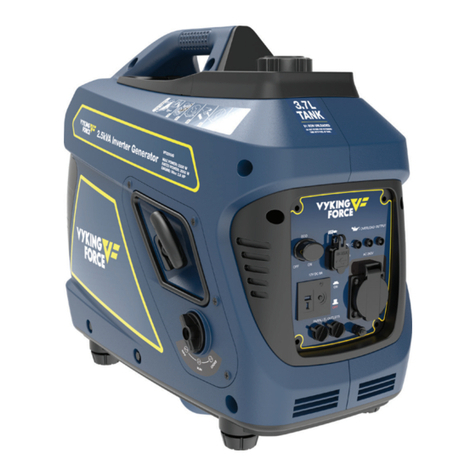
VYKING FORCE
VYKING FORCE VF2200IG instruction manual
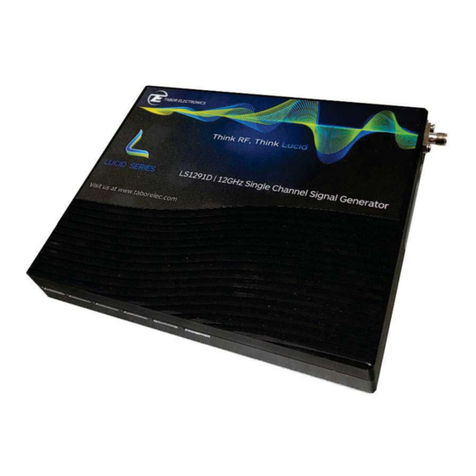
Tabor Electronics
Tabor Electronics Lucid Series user manual

Champion Power Equipment
Champion Power Equipment 46515 Owner's Manual and Operating Instructions
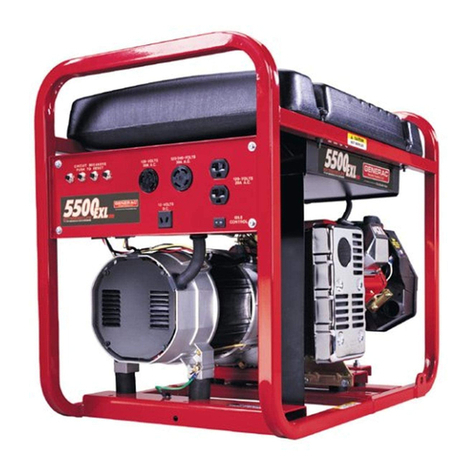
Generac Power Systems
Generac Power Systems 5500EXL Generator user manual
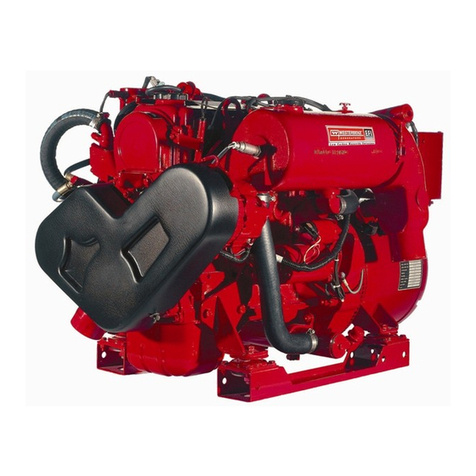
Westerbeke
Westerbeke 7.5 MCGA Operator's manual

Rigol
Rigol DSG5000 Series Programming guide
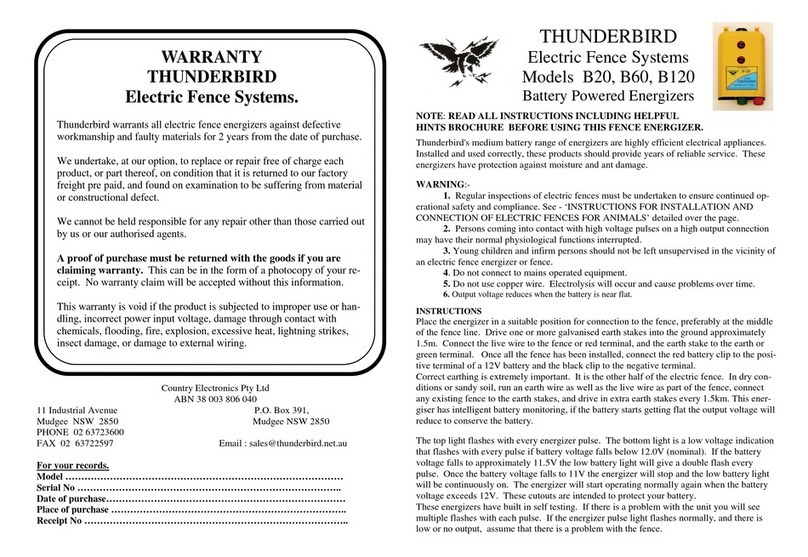
Thunderbird
Thunderbird B20 instructions

Porter-Cable
Porter-Cable D27243-028-0 instruction manual
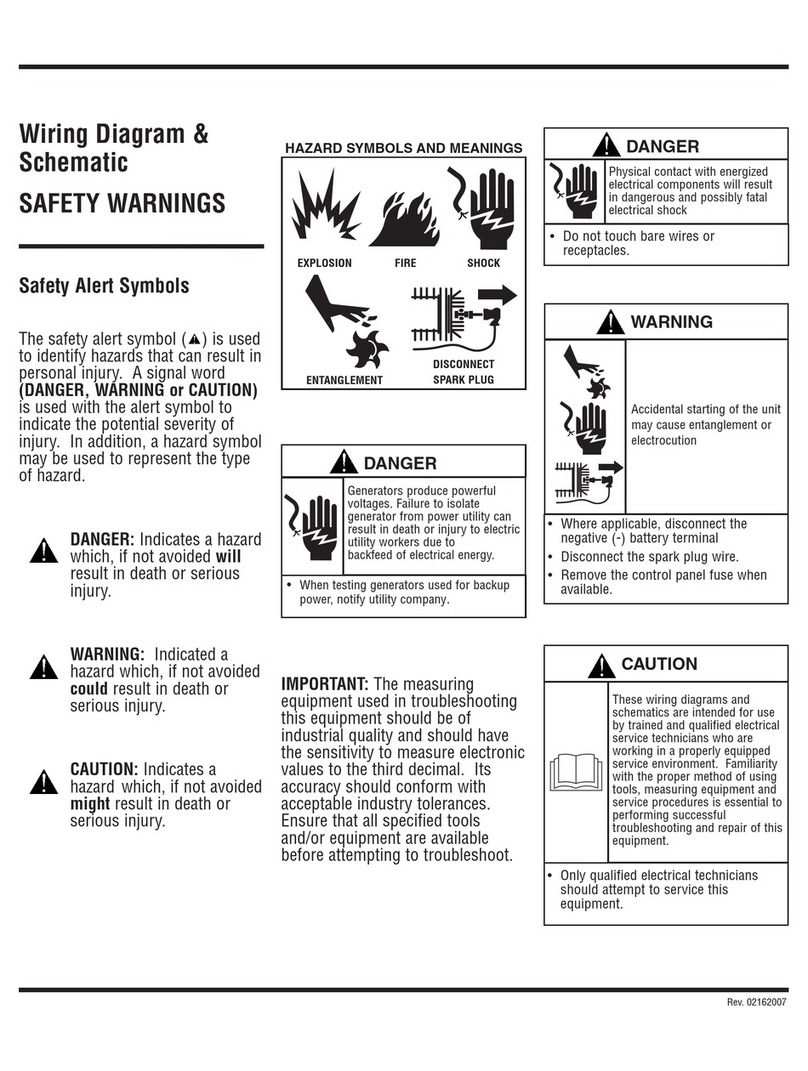
Briggs & Stratton
Briggs & Stratton 30335 Wiring diagrams
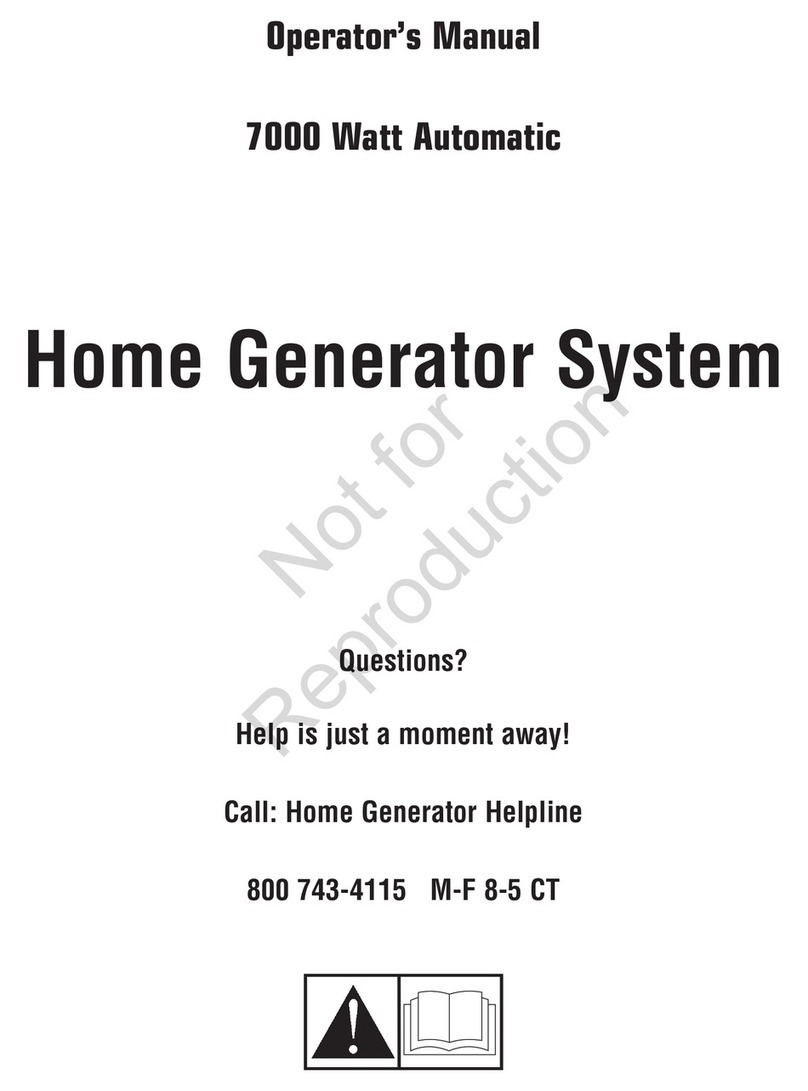
Briggs & Stratton
Briggs & Stratton 7000 Watt Automatic Operator's manual
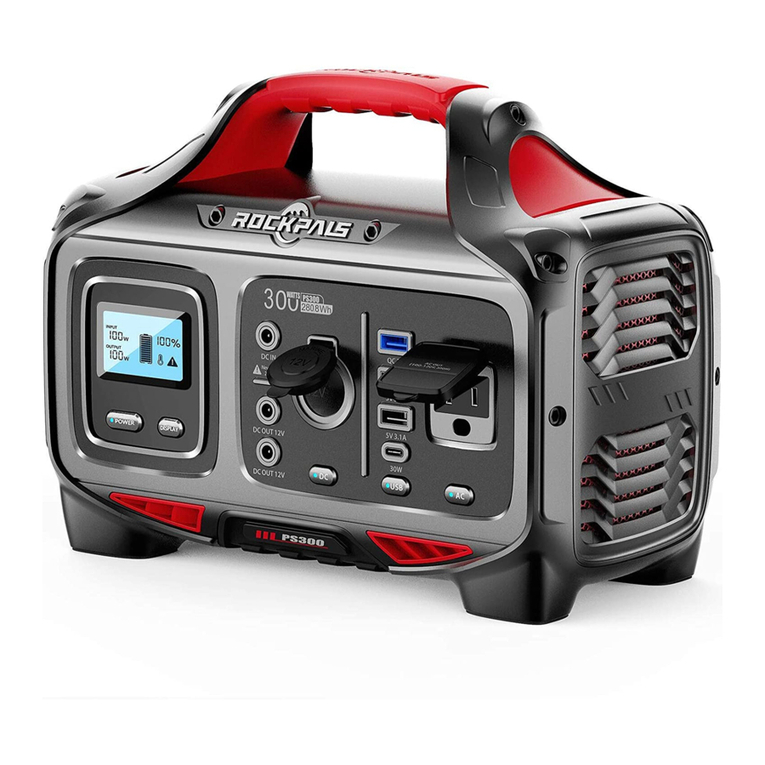
Rockpals
Rockpals Rockpower 300 user guide
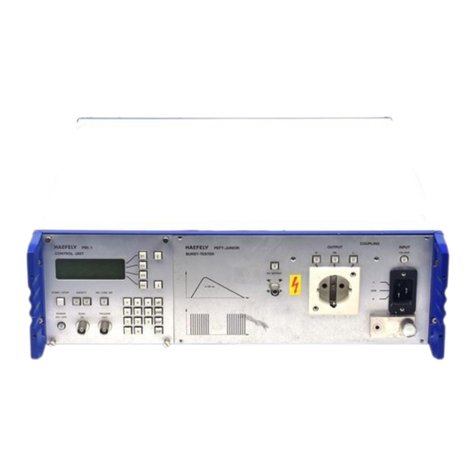
artisan
artisan PEFT Junior user manual

